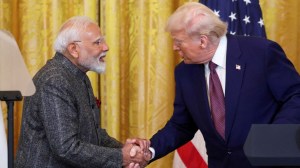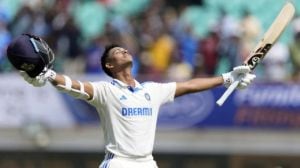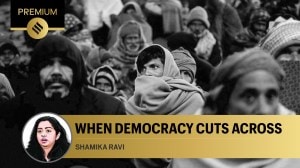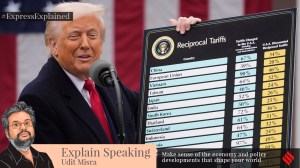UPSC Key: Green Credit Programme, Sahyog portal and Deep sea mining
How is the Green Credit Programme relevant to the UPSC exam? What significance do topics like the Sahyog portal, deep sea mining, and reciprocal tariffs have for both the preliminary and main exams? You can learn more by reading the Indian Express UPSC Key for March 31, 2025.
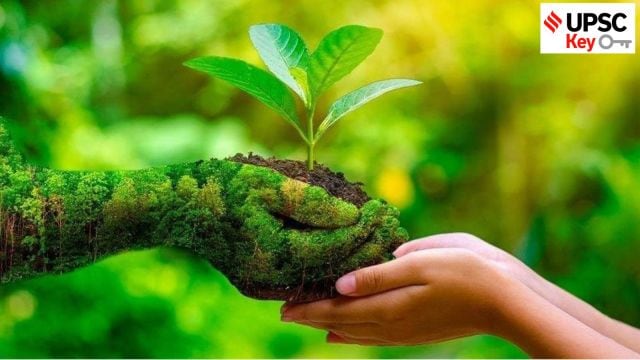 Under the Green Credit Programme, individuals, communities and private industries that engage in environment-positive actions get tradable ‘green credits’. Know more in our UPSC Key. (FB/Miplvp Institute of Social Work)
Under the Green Credit Programme, individuals, communities and private industries that engage in environment-positive actions get tradable ‘green credits’. Know more in our UPSC Key. (FB/Miplvp Institute of Social Work)Important topics and their relevance in UPSC CSE exam for March 31, 2025. If you missed the March 30, 2025, UPSC CSE exam key from the Indian Express, read it here.
FRONT
Before rolling out Green Credits, MoEF sidestepped Law queries
Syllabus:
Preliminary Examination: General issues on Environmental Ecology, Biodiversity and Climate Change- that do not require subject specialization.
Mains Examination: General Studies-II, III: Government policies and interventions, Conservation, environmental pollution and degradation, environmental impact assessment.
What’s the ongoing story: The Environment Ministry’s ambitious Green Credit Programme (GCP), which aims to enhance the country’s forest and tree cover and encourage “pro-planet actions”, was rolled out despite apprehensions from the Law Ministry, records obtained by The Indian Express under the Right to Information (RTI) Act show.
Key Points to Ponder:
• What is the Green Credit Programme?
• What are the objectives of GCP?
• Read about the Environment (Protection) Act, 1986.
• What do you understand by the term “carbon credit”?
• What is a carbon credit trading scheme?
• How is Green Credits Programme different from the carbon credits initiative?
• What are the concerns associated with the GCP?
• What measures should be taken to achieve a balance between environmental conservation and socioeconomic development?
Key Takeaways:
• Under the programme, individuals, communities and private industries that engage in environment-positive actions get tradable ‘green credits’. Such actions could include increasing forest cover, water management, and sustainable agriculture. These credits can then be traded on a domestic platform to meet legal obligations such as compensatory afforestation for industrial or infrastructure projects.
• Since its launch, 384 entities, including 41 PSUs such as Indian Oil Corporation Ltd, Power Grid Corporation of India Ltd, and National Thermal Power Corporation Ltd, have registered for participation under the scheme.
• According to records obtained under the RTI Act, Environment Minister Bhupender Yadav approved the final draft of the Green Credit Rules on August 18, 2023, before sending it to the Law Ministry’s Legislative Department for vetting.
• On October 5, 2023, the Legislative Department, apart from suggesting tweaks from a drafting angle, noted, “Perhaps, the provisions of the Environment (Protection) Act, 1986, do not support such business objects or activity and rules to be framed for the purposes. In view of the above, the administrative ministry may examine the legality of the proposed Green Credit Rules in consultation with the Department of Legal Affairs.”
• Explaining the rationale, a highly placed source in the Law Ministry drew a parallel with the Energy Conservation Act, which was amended in 2023 to enable the creation of a carbon credit trading scheme after the Law Ministry made similar observations on the market-linked mechanism.
• In response to the Law Ministry’s suggestion, the Environment Ministry argued that the GCP simply supported environmental protection and improvement, placing it well within the scope of the EPA.
Do You Know:
• The Green Credits Programme is an effort to create a market-based incentive for different kinds of environment-positive actions, not just for carbon emission reductions. Such a market-based system already exists for carbon, at the national as well as international level, that allows trade in carbon credits. Companies, or nations, can claim carbon credits if they take action to reduce their carbon footprint. These credits can they be traded for money. Companies unable to achieve their emission standards pay to buy these credits and improve their performance.
• At COP28, PM Modi offered the concept to the international community, in the hope to create a market for green credits at an international level, just like the one on carbon credits exists.
Other Important Articles Covering the same topic:
📍What is the Green Credits scheme, which PM Modi mentioned at COP28
📍The green credit strategy — potential and pitfalls
📍Green credits: Govt nod to 12 projects, 24 under consideration
Previous year UPSC Prelims Questions Covering similar theme:
(1) Regarding “carbon credits”, which one of the following statements is not correct? (2011)
(a) The carbon credit system was ratified in conjunction with the Kyoto Protocol
(b) Carbon credits are awarded to countries or groups that have reduced greenhouse gases below their emission quota
(c) The goal of the carbon credit system is to limit the increase of carbon dioxide emission
(d) Carbon credits are traded at a price fixed from time to time by the United Nations Environment Programme.
(2) The concept of carbon credit originated from which one of the following? (UPSC CSE 2009)
(a) Earth Summit, Rio de Janeiro
(b) Kyoto Protocol
(c) Montreal Protocol
(d) G-8 Summit, Heiligendamm
Previous year UPSC Mains Question Covering similar theme:
Should the pursuit of carbon credits and clean development mechanisms set up under UNFCCC be maintained even though there has been a massive slide in the value of a carbon credit? Discuss with respect to India’s energy needs for economic growth. (UPSC CSE 2014)
EXPRESS NETWORK
Govt to HC: X calling Sahyog ‘censorship’ portal is condemnable
Syllabus:
Preliminary Examination: Current events of national and international importance
Mains Examination: General Studies-II, III: Government policies and interventions for development in various sectors and issues arising out of their design and implementation, Awareness in the fields of IT, Computers.
What’s the ongoing story: The Centre has informed the Karnataka High Court that Elon Musk’s social media platform X referring to the government’s Sahyog portal as a “censorship portal” is “unfortunate” and “condemnable”. It also said 38 leading IT intermediaries — including Google, Microsoft, Amazon, Telegram, Apple, Sharechat, Snapchat, LinkedIn, and YouTube — have already joined the portal, which comes under the Ministry of Home Affairs (MHA).
Key Points to Ponder:
• What is the “Sahyog” portal? What is the objective of this portal?
• What are the key provisions of the Information Technology Act, 2000?
(Thought Process: Know in detail about the Section 69A, Section 79 and section 79(3)(b) of IT Act, 2000)
• What is Safe Harbour Protection?
• What was the Supreme Court ruling in the Shreya Singhal v Union of India?
• What are the rights provided under articles 19, 14 and 21 of the Constitution of India?
• What are the rights protected under Article 19? What are the “reasonable restrictions” provided by Article 19?
• What measures have been taken by the government to regulate social media in India?
• What are the advantages and disadvantages of social media?
• How does the concept of safe harbour protection balance the competing interests of free speech and the necessity to regulate harmful content?
Key Takeaways:
• On March 17, X filed a lawsuit against the Centre challenging the use of Section 79(3)(b) of the IT Act, 2000, to issue blocking orders, claiming that it leads to the creation of a “parallel” and “unlawful” content censorship regime.
• The company also sought protection for its representatives and employees against coercive action for not joining Sahyog.
• The Centre, in its Statement of Objections submitted to the HC, has listed an array of arguments against X’s earlier contentions. The case will be next heard on April 3.
• The Centre said X’s petition was merely camouflaged as seeking interpretations of sections 79 and 69A, whereas it was actually seeking to press rights it did not possess under articles 19, 14 and 21 of the Constitution. It said as a foreign entity, the only right that X would have are the “safe harbour” protections.
Do You Know:
• Under Section 79 of the Information Technology Act, 2000, the social media intermediaries such as X, Telegram, Facebook, Instagram, etc., have the immunity against legal prosecution for content posted by users.
• Section 79 says any intermediary shall not be held legally or otherwise liable for any third party information, data, or communication link made available or hosted on its platform.
• However, section 79(3)(b) states that the intermediary could be held liable if it does not immediately remove such unlawful information “upon receiving actual knowledge, or on being notified by the appropriate Government or its agency”.
• The apex court in Shreya Singhal v Union of India (2015) case limited the scope of this provision, ruling that the requirement under Section 79(3)(b) will only kick in once a court order has been passed to that effect, or the government issues a notification stating that the content in question is related to grounds provided in Article 19(2).
• But in October 2023, the Ministry of Electronics and Information Technology (MeitY) issued a directive to all ministries, state governments, and the police saying that information blocking orders could be issued under Section 79(3)(b).
• A year later in October 2024, MeitY launched a portal called “Sahyog” where the aforementioned authorities could issue and upload blocking orders.
Other Important Articles Covering the same topic:
📍Knowledge Nugget: Grok AI and Safe Harbour Protection – What you must know for UPSC Exam?
📍Why X has challenged govt’s use of Section 79 of the IT Act
Previous year UPSC Prelims Question Covering similar theme:
(3) Consider the following statements:
1. Safe harbour clause is prescribed under Section 79 of the IT Act, 2000.
2. Safe harbour is legal immunity that online intermediaries enjoy against content posted by users on their platforms.
Which of the statements given above is/are correct?
(a) 1 only
(b) 2 only
(c) Both 1 and 2
(d) Neither 1 nor 2
Previous year UPSC Mains Question Covering similar theme:
Discuss Section 66A of IT Act, with reference to its alleged violation of Article 19 of the Constitution. (UPSC CSE 2013)
THE EDITORIAL PAGE
A judge in the dock
Syllabus:
Preliminary Examination: Current events of national importance and Polity
Mains Examination: General Studies-II: Separation of powers between various organs dispute redressal mechanisms and institutions.
What’s the ongoing story: Upendra Baxi writes- “The Supreme Court’s timely three-member judicial enquiry into corruption allegations against Justice Yashwant Varma is a welcome initial move. It has become both the talk of the town and of the gown.”
Key Points to Ponder:
• Read about the Justice Yashwant Varma case.
• What are the constitutional provisions related to the Indian Judiciary?
• What is the Supreme Court Collegium?
• What mechanisms are in place within the Indian judiciary to investigate allegations against sitting judges?
• How does financial misconduct by a judge affect public trust in the judiciary?
• What reforms could be introduced to enhance transparency in judicial inquiries, appointments, and disciplinary actions?
• Is the Indian judiciary covered under the Lokpal and Lokayukta Act, 2013?
• Read about the National Judicial Appointments Commission (NJAC) Act.
• What is the significance of judicial accountability in ensuring the independence of the judiciary in India?
Key Takeaways:
• “Everyone agrees that releasing all the details of the allegations on the website of the Supreme Court is a big and bold move by Chief Justice of India Sanjiv Khanna and the Supreme Court Collegium.”
• “At the outset, it needs to be acknowledged that ours is an adversarial justice system, in which no person can be held guilty unless so decreed by a competent forum of law. Justice Varma has denied all wrongdoing and has suggested that there is a deep “conspiracy” against him. The presumption of innocence is a cornerstone of the administration of justice, and fair trial is a fundamental right of all citizens accused of a crime.”
• “It would be misleading and erroneous to regard the concerned judge as “guilty”, no matter how strong the prima facie case against him may appear, and regardless of the mass media and public perceptions.”
• “At the same time, the CJI and the collegium are justified in taking suitable administrative action, within their competence, and have decided both to transfer the justice to his parent court, the Allahabad HC, and then to de-roster him pending enquiry. The ire of the Allahabad HC Bar Association over this is understandable but the language they have used is not. No court is to be regarded as a “dumping ground” for “corrupt” and “tainted” justices, and the policy needs a sustained second look as merely transferring a justice accused of corruption is no answer at all to the underlying problem.”
• “Addressing a distinguished gathering of justices and jurists, Jagdeep Dhankhar, the Vice President, recently said that the Supreme Court’s decision to strike down the NJAC constitutional amendment and the Act was a “scenario perhaps unparalleled in the democratic history of the world”.”
• “True, the angst over the striking down of the NJAC amendment centred on the fact that it had been passed by Parliament with only one dissent (veteran lawyer Ram Jethmalani being the sole voice against the amendment) and ratified by 18 states.”
• “The majority (led by Justice Jagdish Singh Khehar) carefully declared the NJAC void as it would breed a culture of “reciprocity” of favours between the government and the judiciary, and thus “destroy” the integrity of the structures of the constitutional judicial review, and he pointedly asked how future judges appointed under the NJAC could be independent-minded when the NJAC was “exclusively placed under the control of the executive”.
• “Contrary to a semi-literate reading of the decision (which perpetuates the convenient political myth of judges appointing judges), the majority upheld the President’s power to appoint justices subject to the advice of the judicial Collegium. The collision now is between the two constitutionally “limited” primacies — that of the President and the Collegium.”
• “There is currently plenty of evidence to suggest a constitutional dyarchy at work, wherein both the executive and judiciary together agree on the nominations, save perhaps when the Collegium reiterates its decision. However, the present event of alleged judicial corruption scarcely bears the weight for any re-consideration of the Collegium as the concerned Justice was elevated by both the competent constitutional authorities.”
Do You Know:
• The Justice M N Venkatachaliah Commission, appointed by Prime Minister Atal Bihari Vajpayee in 2000, recommended the creation of a National Judicial Appointments Commission (NJAC) to replace the collegium.
• In August 2014, Parliament passed the Constitution (99th Amendment) Act, 2014, and the National Judicial Appointments Commission (NJAC) Act, 2014. These two laws provided for an independent commission to appoint judges to the SC and High Courts, replacing the collegium system.
• The NJAC was to comprise the Chief Justice of India as the ex officio Chairperson, two senior-most Supreme Court Judges as ex officio members, the Union Minister of Law and Justice as ex officio member, and two eminent persons from civil society — one of whom would be nominated by a committee consisting of the CJI, Prime Minster and the Leader of Opposition in the Lok Sabha, and the other would be nominated from the SC/ST/OBC/minority communities or women. The laws were repealed in October 2015 after the Supreme Court struck them down.
Other Important Articles Covering the same topic:
📍Express View on Justice Yashwant Varma case: An open justice
Previous year UPSC Prelims Question Covering similar theme:
(4) Consider the following statements: ( UPSC CSE 2019)
1. The 44th Amendment to the Constitution of India introduced an Article placing the election of the Prime Minister beyond judicial review.
2. The Supreme Court of India struck down the 99th Amendment to the Constitution of India as being violative of the independence of judiciary.
Which of the statements given above is/are correct?
(a) 1 only
(b) 2 only
(c) Both 1 and 2
(d) Neither 1 nor 2
Previous year UPSC Mains Question Covering similar theme:
Critically examine the Supreme Court’s judgment on ‘National Judicial Appointments Commission Act, 2014’ with reference to the appointment of judges of higher judiciary in India. (UPSC CSE 2017)
THE IDEAS PAGE
The nuclear leap
Syllabus:
Preliminary Examination: Current events of national importance and development
Mains Examination: General Studies-II, III: Government policies and interventions; Economic development, Indigenization of technology and developing new technology.
What’s the ongoing story: Jitendra Singh writes- “As the world’s fifth-largest economy with a population of over 1.4 billion, India’s thirst for energy grows exponentially each year. India’s electricity demand is projected to triple by 2047, but nearly 70 per cent of power generation still comes from fossil fuels. This paradox defines India’s energy challenge — how to promote rapid economic growth while simultaneously reducing carbon emissions and ensuring energy security. Nuclear power has emerged as a crucial pillar in India’s quest for a sustainable and self-reliant energy future.”
Key Points to Ponder:
• Read about India’s atomic energy programme and Nuclear Energy Mission.
• What are small modular reactors (SMRs)?
• How are SMRs different from traditional nuclear reactors?
• What role can SMRs play in India’s energy security and its transition towards cleaner energy sources?
• What are the advantages of nuclear energy?
• What are the challenges faced by India in the nuclear energy sector?
• Can the private sector lead India’s nuclear power journey?
• What is India’s Nuclear doctrine?
• Read about the Bhabha Atomic Research Centre (BARC)
Key Takeaways:
• “Nuclear energy represents one of the most concentrated forms of power generation, where small amounts of fuel can produce enormous quantities of electricity with minimal carbon emissions. France, which generates over 70 per cent of its electricity from nuclear sources, has demonstrated how this technology can form the backbone of a low-carbon energy strategy.”
• “For India, the challenges are multifaceted. The country’s heavy dependence on imported fossil fuels not only strains the economy but also increases vulnerability to global price fluctuations. Simultaneously, as a signatory to international climate agreements, India has committed to reducing its carbon footprint significantly.”
• “Unlike intermittent renewable sources such as solar and wind, nuclear power provides reliable baseload generation regardless of weather conditions. While hydropower faces seasonal variations and ecological concerns, and coal continues to pose serious environmental challenges, nuclear energy offers a sustainable alternative.”
• “At the heart of India’s nuclear strategy lies the visionary three-stage nuclear programme designed by Homi Bhabha, who envisaged using nuclear energy for peaceful purposes. It aims to leverage India’s abundant thorium reserves — the world’s largest — to eventually achieve complete energy self-sufficiency, a goal that has gained renewed urgency as the country works toward its net-zero target by 2070.”
• “While nuclear power currently contributes approximately 3 per cent of India’s electricity generation, this figure is set to grow substantially with 21 reactors totalling 15,300 MW at various stages of implementation.”
• “The successful commissioning of India’s first indigenous 700 MWe Pressurised Heavy Water Reactor (PHWR) at Kakrapar, Gujarat in 2023-24 marks a significant milestone in self-reliance. The country has also made strides in nuclear fuel cycle capabilities, with the Prototype Fast Breeder Reactor (PFBR) achieving critical milestones in 2024, including primary sodium filling and commissioning of sodium pumps.”
• “A revolutionary development is the focus on Small Modular Reactors (SMRs) and Bharat Small Reactors (BSRs). The budget has allocated Rs 20,000 crore for SMR research and development, aiming to develop at least five indigenously designed operational SMRs by 2033.”
• “The government has set a target of 100 GW nuclear power capacity by 2047, a massive increase from the current 8.18 GW. To achieve this, the Nuclear Energy Mission for Viksit Bharat has been launched, focusing on enhancing domestic capabilities.”
• “International collaborations have been reinvigorated, particularly with Russia, France, and the US. The government has accorded in-principle approval to set up six 1208 MW nuclear power plants in cooperation with the US at Kovvada in Andhra Pradesh.”
Do You Know:
• India’s nuclear journey began shortly after Independence with the establishment of the Atomic Energy Commission in 1948. In 1956, Asia’s first research reactor, Apsara, was commissioned at the Bhabha Atomic Research Centre (BARC) in Trombay. These early steps laid the foundation for what would become one of the world’s most comprehensive nuclear programmes.
• In her budget speech, Finance Minister Nirmala Sitharaman said the government would set up a Nuclear Energy Mission worth ₹20,000 crore for research and development of SMRs, and promised that at least five such indigenously developed SMRs would be operationalised by 2033.
• The Finance Minister also promised to amend the Atomic Energy Act and the Civil Liability for Nuclear Damage Act to accelerate private sector participation in building and operating nuclear power plants.
• Notably, unlike renewables like solar or wind, nuclear energy offers a reliable source of on demand electricity generation, and is not susceptible to weather-related interruptions.
• The International Atomic Energy Agency (IAEA), an international body that advises governments on the transition to clean energy, says nuclear energy has to more than double by 2050 if the world has any chance of reaching net zero. The problem with nuclear power currently is that it is big and expensive, takes too long to build and could cause civilisation-ending disasters if something were to go wrong.
Other Important Articles Covering the same topic:
📍Knowledge Nugget: How is Nuclear Energy Mission and Small Modular Reactors relevant for UPSC Exam?
UPSC Prelims Practice Question Covering similar theme:
(5) Which of the statements about Small Modular Reactors (SMRs) are correct?
1. It aims to achieve net-zero emissions while ensuring energy security.
2. These have a power generation capacity ranging from less than 30 MWe to 300+ MWe.
3. These are cost-effective alternatives to conventional large nuclear reactors.
4. They are suitable only for on-grid and not for off-grid applications.
Select the correct answer using the codes given below:
(a) 1 and 2 only
(b) 2, 3 and 4
(c) 3 and 4 only
(d) 1, 2 and 3
Thread and weave of reform
Syllabus:
Preliminary Examination: Current events of national and international importance
Mains Examination: General Studies-II: Indian Economy and issues relating to planning, mobilisation, of resources, growth, development and employment
What’s the ongoing story: Ashok Gulati, Ritika Juneja and Sulakshana Rao write- “India has set an ambitious target to elevate its textile and apparel (T&A) exports from $34.8 billion in 2023-24 to an eye-popping $100 billion by 2030. This raises a critical question — is this lofty ambition grounded in reality or is it just a daydream?”
Key Points to Ponder:
• What is the current status of the Textile Sector in India?
• What is the Pradhan Mantri Mega Integrated Textile Region and Apparel (PM-MITRA)?
• What is the share of the textile sector in the Indian economy?
• What is the contribution of the textile sector to employment?
• What are the challenges facing the textile sector?
• What are the key initiatives taken by the government for the growth of Textile sector and boosting textile export?
Key Takeaways:
• “If we look at the long-term trends, India’s T&A exports have grown steadily from $11.5 billion in FY2001 to $34.8 billion in FY24, accounting for only a 4 per cent share in global exports of $774.4 billion. At this pace, achieving the $100 billion target by 2030 seems a tall order unless dramatic, game-changing reforms are introduced.”
• “India should not only focus on apparel exports, but the exports of the entire T&A sector if it is to achieve its target of $100 billion . For this, let us dig into the challenges that lie ahead in the textile value chain — from farm to foreign.”
• “India is likely to become a net importer of cotton, with imports reaching 2.6 million bales, surpassing exports of just 1.5 million bales in the marketing year 2024-25. This marks a significant decline from peak exports of 11.7 million bales in FY14. This debacle is largely caused by not allowing the next-generation herbicide tolerant (Ht) Bt seeds to come into India, despite clearance by the apex Genetic Engineering Appraisal Committee (GEAC) under the Ministry of Environment, Forest and Climate Change.”
• “India has over 1 lakh garment factories, but most of them (about 80 per cent) are in the decentralised sector. Its exports are way below its potential. Slow adoption of modern technology and weak value chain integration are key barriers…While the Pradhan Mantri Mega Integrated Textile Region and Apparel (PM-MITRA) scheme aims to develop integrated textile parks, high land requirements exclude MSMEs, limiting its reach.”
• “To overcome the challenges and achieve the ambitious target of T&A exports by 2030, India must adopt a strategic approach and implement bold policy reforms.
• “First, India’s garment sector needs to transition into a fashion-driven industry. To support this transformation, it is crucial to incentivise and invest in MMF-based apparel while removing non-tariff barriers, such as the quality control orders on MMF.”
• “Second, the PM-MITRA scheme must be fast-tracked to create integrated textile hubs, which will enhance scalability and efficiency in fabric and garment manufacturing.”
• “Third, negotiating Free Trade Agreements (FTAs) with the EU and the US — key markets that account for nearly 66 percent of India’s apparel exports — could offer a substantial boost.”
• “Fourth, improving cotton productivity and fibre quality is a critical step. India’s significant advantage lies in its strong base of natural fibre production, particularly cotton, which is underutilised.”
• “By addressing these critical areas, India may position itself for a much-needed leap in T&A exports, moving slightly closer to its ambitious target of $100 billion by 2030. But, this is feasible only if the Modi government embraces these bold reforms. Else, it will remain a daydream.”
Other Important Articles Covering the same topic:
📍India can be the world leader in textiles. Here’s how
📍Leader in fibre production, but growth, exports lagging: What ails India’s textile industry
Previous year UPSC Prelims Question Covering similar theme:
(6) Consider the following statements: (UPSC CSE 2020)
1. The value of Indo-Sri Lanka trade has consistently increased in the last decade.
2. Textile and textile articles” constitute an important item of trade between India and Bangladesh.
3. In the last five years, Nepal has been the largest trading partner of India in South Asia.
Which of the statements given above is/are correct?
(a) 1 and 2 only
(b) 2 only
(c) 3 only
(d) 1, 2 and 3
Previous year UPSC Mains Question Covering similar theme:
Analyse the factors for the highly decentralised cotton textile industry in India. ( UPSC CSE 2013)
EXPLAINED
What a new study found about the long-term impact of deep sea mining
Syllabus:
Preliminary Examination: Current events of national and international importance.
Mains Examination: General Studies-III: Conservation, environmental pollution and degradation, environmental impact assessment.
What’s the ongoing story: A strip of the Pacific Ocean seabed that was mined for metals more than 40 years ago has still not recovered, according to a new study. It said that the mining had led to long-term sediment changes and reduced the populations of many of the larger organisms living there.
Key Points to Ponder:
• What is deep sea mining?
• What are the different types of deep-sea mining?
• Why are deep-sea minerals considered strategically significant for countries?
• What is Samudrayaan Mission?
• What is Matsya-6000?
• How is India’s Deep Ocean Mission, including the Samudrayaan project, crucial for ensuring resource security?
• What are the environmental concerns associated with deep-sea mining?
Key Takeaways:
• Deep sea mining involves removing mineral deposits and metals from the ocean’s seabed. There are three types of such mining: taking deposit-rich polymetallic nodules off the ocean floor, mining massive seafloor sulphide deposits, and stripping cobalt crusts from rock.
• These nodules, deposits and crusts contain materials, such as nickel, rare earths, cobalt and more, that are needed for batteries and other materials used in tapping renewable energy and also for everyday technology like cellphones and computers.
• Engineering and technology used for deep sea mining are still evolving. Some companies are looking to vacuum materials from the seafloor using massive pumps. Others are developing artificial intelligence-based technology that would teach deep sea robots how to pluck nodules from the floor. Some are looking to use advanced machines that could mine materials offside of huge underwater mountains and volcanoes.
• Companies and governments view these as strategically important resources that will be needed as onshore reserves are depleted and demand continues to rise.
• The study examined the impact of a small-scale mining experiment on a part of the Pacific Ocean’s seafloor. Carried out in 1979, the experiment involved removing polymetallic nodules off the seabed. The scientists analysed the 8-metre strip during an expedition in 2023.
• They found that the experiment had led to long-term changes in the sediment of the area, and a dip in the population of the organisms living there.
Do You Know:
• The intense oceanic activity around the world over the past two decades has focused on the Deep both for its economic resources and as the theatre of possible future conflicts.
• According to the United Nations Convention on the Law of the Seas (UNCLOS), the Exclusive Economic Zone (EEZ) of a country extends from the baseline of its coast to 200 nautical miles (about 370 km) into the sea. A nation has exclusive rights to living and non-living resources in the waters and on the seabed within its EEZ.
Other Important Articles Covering the same topic:
📍Expert Explains: Why India needs to develop its deep sea capabilities
Previous year UPSC Prelims Question Covering similar theme:
(7) Consider the following:
1. Rich polymetallic nodules
2. Sulphide deposits
3. Cobalt crusts from rock
How many of the above are associated with deep-sea mining?
(a) Only one
(b) Only two
(c) All three
(d) None
Trump’s global tariffs
Syllabus:
Preliminary Examination: Current events of national and international importance, Economic Development
Main Examination: General Studies II: Effect of policies and politics of developed and developing countries on India’s interests.
What’s the ongoing story: Policymakers and investors across the world are waiting anxiously for April 2, when US President Donald Trump is set to announce “reciprocal tariffs” on the rest of the world and celebrate the move as “Liberation Day” for the US. No one has any clarity on how reciprocal tariffs will be calculated for each country; for instance, whether domestic subsidies or tax incentives or non-tariff barriers will also be factored in while arriving at the reciprocal tariff number.
Key Points to Ponder:
• What are tariffs and how do tariffs work?
• What are the key reasons behind the recent US government’s decision to increase tariffs?
• How do countries generally retaliate against tariffs, and what are the potential consequences of such retaliatory measures?
• What would be the impact of reciprocal tariffs on India?
• What strategies should India employ to navigate potential trade negotiations with the U.S.?
• What are the areas of cooperation between India and the US?
• What is the bilateral trade agreement between India and the USA?
Key Takeaways:
• Since tariffs alter the effective prices of goods and services, a move of such a global scale by the world’s largest economy — whose currency is the default global currency — can potentially lead to upheavals in prices of different assets, be it the stock markets, gold, currency exchange rates and even real estate.
• Depending on the severity of the move, it can affect economic growth, inflation and interest rates across the world. The turmoil in global markets — especially in the US — since Trump took over is a good precursor.
• The obvious question is: What is the problem that Donald Trump is trying to solve?
• On the face of it, the US’ trillion dollar trade deficit — the gap between the value of its imports and exports — is the trigger. But the underlying cause for this is the “over-valuation” of the US dollar. The dollar has been “over-valued” because it is the default currency for the world and as such its demand never falls, not even when the US economy struggles.
• ‘The deep unhappiness with the prevailing economic order is rooted in persistent overvaluation of the dollar and asymmetric trade conditions. Such overvaluation makes U.S. exports less competitive, U.S. imports cheaper, and handicaps American manufacturing. Manufacturing employment declines as factories close. Those local economies subside, many working families are unable to support themselves and become addicted to government handouts or opioids or move to more prosperous locations. Infrastructure declines as governments no longer service it, and housing and factories lay abandoned. Communities are “blighted.”’
• Of course, the dollar’s strength and status also has many advantages such as a strong purchasing power to import goods from anywhere in the world, the ability to borrow at very low interest rates, as well as the ability to sanction and shut out any foreign country from the international financial order dominated by the US.
• In the past, the US has got together with its trade partners to orchestrate a devaluation of the dollar (the Plaza Accord of 1985). Many expected a similar exercise this time around as well — the Mar-a-Lago Accord. However, Trump is more favourably inclined towards the use of tariffs.
Do You Know:
• Tariffs are taxes or duties imposed by a government on imported goods and services. Their objective is to make foreign products more expensive compared to domestically produced goods, thereby encouraging consumers to prefer local products. Tariffs also act as a protective measure for domestic industries against foreign competition. Additionally, they serve as a source of revenue for the government.
Other Important Articles Covering the same topic:
📍UPSC Issue at a Glance | Tariff war: 4 Key Questions You Must Know for Prelims and Mains
📍UPSC Issue at a Glance | PM Modi’s US Visit: 4 Key Questions You Must Know for Prelims and Mains
UPSC Prelims Practice Question Covering similar theme:
(8) Consider the following statements:
1. Tariffs are taxes or duties imposed by a government on imported goods and services.
2. Objective of tariffs is to make foreign products more expensive compared to domestically produced goods
Which of the statements given above is/are correct?
(a) 1 only
(b) 2 only
(c) Both 1 and 2
(d) Neither 1 nor 2
UPSC Previous Year Mains Question Covering similar theme:
What are the key areas of reform if the WTO has to survive in the present context of ‘Trade War’, especially keeping in mind the interest of India? (UPSC CSE 2018)
| ALSO IN NEWS | |
| In celebration of tribal festival Sarhul, link to communities’ history, politics | Adivasis in Jharkhand and the larger Chhotanagpur region will welcome the new year and the spring season with the Sarhul festival on Tuesday. Sarhul, literally “worship of the Sal tree”, is among the most revered Adivasi festivals. It is rooted in nature worship and celebrates the symbolic union of the Sun and the Earth. Only after the rituals are completed do Adivasi folk begin ploughing their fields, sowing their crop, or entering the forest to gather produce. Sarhul has been celebrated by tribes such as the Oraon, Munda, Santal, Khadia, and Ho, with unique names for the festival and particular ways of celebrations. Today, the festival is also celebrated in locations ranging from the tea gardens of Assam to the Andaman and Nicobar Islands, Nepal, Bangladesh, and Bhutan. |
| Set up bridge research centres, window for clearance of iconic structures: Rly panel | The urgent need for an advanced centre on bridge research, a special window for clearance of iconic structures, and preservation of all records of building such bridges — these are some of the suggestions made by a special committee of Railways, which was formed to look into the “lapses” flagged by the Commission of Railway Safety (CRS) regarding the construction of iconic Pamban bridge in Tamil Nadu in November, 2024. The bridge connects Rameswaram on Pamban island with Mandapam station in mainland India. Prime Minister Narendra Modi is set to inaugurate Pamban bridge on the occasion of Ram Navami (April 6). Sources said that Modi will also inaugurate the 15th train on the Pamban route. |
| Kathmandu protests: why some Nepalis want King’s return | On Friday evening (March 28), the army was called out as supporters of the restoration of the constitutional monarchy swarmed the streets of Kathmandu, outnumbering the attendees of a rally of the Left Front, and clashing violently with police. Three individuals were killed, and 110 arrested. On Sunday, MPs from the ruling coalition protested in the House of Representatives demanding the arrest of former King Gyanendra Shah. The pro-monarchy Rastriya Prajatantra Party dared the government to carry out the threat. The former King has not openly expressed a desire to return. He has confined his activities to issuing messages expressing concern over the situation in Nepal, the worsening economic scenario, and the flight of youths abroad in search of livelihood opportunities. |
| Trump says ‘there will be bombing’ if Iran doesn’t agree to nuclear deal | U.S. President Donald Trump threatened Iran on Sunday with bombing and secondary tariffs if Tehran did not come to an agreement with Washington over its nuclear program. In Trump’s first remarks since Iran rejected direct negotiations with Washington last week, he told NBC News that U.S. and Iranian officials were talking, but did not elaborate. Iran sent a response through Oman to a letter from Trump urging Tehran to reach a new nuclear deal, saying its policy was to not engage in direct negotiations with the United States while under its maximum pressure campaign and military threats, Tehran’s foreign minister was quoted as saying on Thursday. |
| Prelims Answer Key |
| 1. (d) 2. (b) 3. (c) 4. (b) 5. (d) 6. (b) 7. (c) 8. (c) |
🚨 Click Here to read the UPSC Essentials magazine for March 2025. Share your views and suggestions in the comment box or at manas.srivastava@indianexpress.com🚨
Subscribe to our UPSC newsletter. Stay updated with the latest UPSC articles by joining our Telegram channel – IndianExpress UPSC Hub, and follow us on Instagram and X.
Must Read
Buzzing Now
Apr 03: Latest News
- 0115 hours ago
- 0215 hours ago
- 0315 hours ago
- 0422 hours ago
- 0516 hours ago




